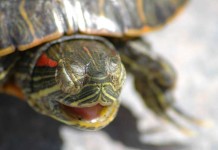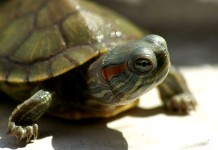Red eared sliders, Trachemys scripta elegans, are by far the most common turtle on the marker in the US. Virtually every pet store you go into will have a small tank off to the side somewhere with a few sliders in it. Red eared sliders have remained a popular pet for so long because of their hardiness, ease of care, and energy. All owners of this wonderful pet should familiarize themselves with the basic red eared slider facts.
First, let’s assume you know nothing about turtles. Yes, they can hold their breath for long periods of time, but the fact is red eared sliders can’t breathe underwater. All turtles, to some degree, are both aquatic and terrestrial. One of the most common mistakes that many red eared slider owners make is not providing their turtle a place to get out of the water. In the wild, red eared sliders spend a lot of time sunning themselves on sun and rocks.
Another mistake that many red eared slider owners make is not providing proper light and filtration for their turtle. Though they don’t breathe water like fish, sliders need quality water of an appropriate temperature (75-86 degrees Fahrenheit). The water must also be kept clean so your pet turtle doesn’t get sick, so make sure you have a good, strong filter of the appropriate size for your tank. Light is also very important for your slider’s health; you want to try and mimic natural sunlight as much as possible, so get an ultraviolet B-producing fluorescent light. If that doesn’t bring the tank’s temperature up to 75 degrees Fahrenheit, you should get a heat lamp.
You also have to make sure that you are feeding your slider the correct diet. You can’t just rely on the commercial pellets out there to get your slider all the nutrition he needs. You have to vary his diet by supplementing the pellets with vegetables, fresh meat, and vitamins. Basically, no more than 25% of the turtle’s diet should be pellets, 25% should be animal protein (live fish, earthworms, chopped beef), 50% should be vegetable matter (dark leafy greens, shredded carrots, squash, green beans and fruit), and top it all off with powdered multivitamin or turtle vitamins (plus a calcium block or cuttlebone for him to chew on).
Hopefully, the red eared slider facts presented here will put you on the right track and let you know what you should be doing. These are just the bare-bones facts, so stay tuned for more details!











